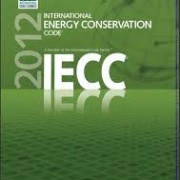Many states are in the process of adopting in whole or with modifications the 2012 International Energy Conservation Code (IECC). This new code raises the bar in construction design for residential and commercial structures, and as a result, architects / engineers / contractors building to the new code will be affordably offer a choice to their clients for pursuing several above-code certifications such as Energy Star and LEED without too much additional effort or cost.

The new national energy code includes mandatory blower-door testing for building air leakage (less than <3.0 ACH at 50 pascals), which will measure how well contractors have sealed up penetrations between the outdoors and indoor conditioned space. This testing will be required for all projects permitted after the new code goes into effect. Some states have made modifications to the adopted code, such as Illinois which has changed the ACH rate to 5.0 ACH @ 50. View our archived July 12 webinar to learn more about IL Energy Code changes.
Other aspects of the 2012 IECC such as requiring hot water pipe insulation and mechanical ventilation are new items that projects will need to implement. Learn more on a free webinar held Thursday July 12.
So, how do national IECC 2012 requirements relate to voluntary above-code programs like Energy Star, LEED and Passive House? Pretty well actually. has assembled a matrix identifying several energy-related items as written in the code and indicated what the impact or requirements would be in one of these above-code third-party green certification programs. Download national comparison matrix as PDF.
(Illinois-specific modifications are shown in the image below)

Download National IECC 2012 Code Comparison matrix as PDF
What does this mean? Well just by building to the new code, these projects will be very close to meeting the Energy Star for Homes program requirements, and will score very well in programs that require Energy Star version 3 such as LEED or Green Communities. Other green programs that don’t require Energy Star, such as National Green Building Standard or local green home programs will also heavily reward these projects.
LEED for Homes will be requiring Energy Star version 3 beginning at the end of the year, so right now a project can still earn LEED certification by building to Energy Star version 2 requirements which should be easily met on any home that meets IECC 2012.
Take advantage of this sweet spot and earn market recognition by attending a LEED workshop or sign up to earn LEED certification today!

